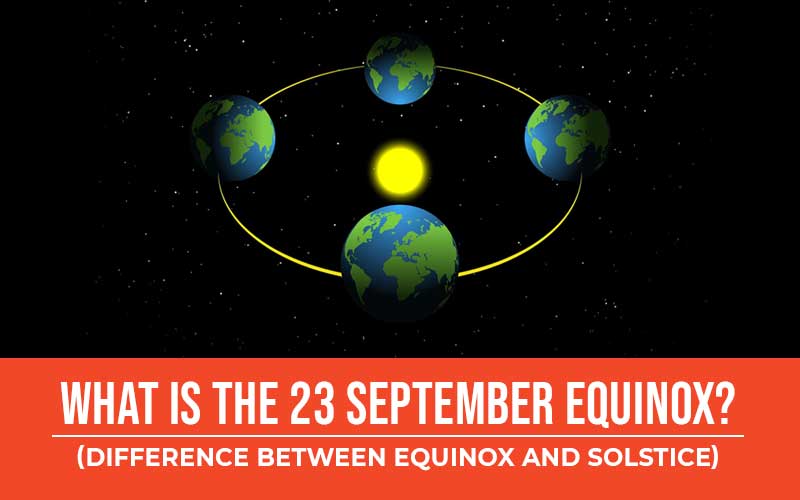
What is the 23 September Equinox? (Difference between Equinox and Solstice)
Our planet Earth is as complex as
the mystery of the human brain and how it functions. Its mysteries never fail
to enthral us, just as our actions and feelings enthral others around us. Earth
passes through a variety of phases and mood swings, from uncommon occurrences
like the Super Blue Blood Lunar Eclipse of 2018 to yearly occurrences like the
seasonal change at solstices and equinoxes. These celestial occurrences reveal
the exact and regular motions of our planet through space, which are a
representation of the natural laws that have fashioned our globe over millions
of years. Let's investigate more to learn the significance of these recurrent
phenomena while awestruck by the intricate beauty and elegance of our house.
The Equinoxes: The Transition Between Seasons
The term "equinoxes" comes from the
Latin words "aequus" (equal) and "nox" (night). They are
classified into two types: vernal (spring) equinoxes and autumnal (fall)
equinoxes. The equinoxes mark the start of spring and autumn, indicating the commencement
of transitional seasons.
They are an important celestial
occurrence that occurs twice a year, marking the moments when the Sun aligns
squarely above the Earth's equator, resulting in an "equal night" or
"equal day" where day and night last almost equal amounts of time.
These moments, which represent the changing seasons, create a delicate
equilibrium in our world.
March Equinox:
The March Equinox, also known as the Vernal
Equinox, occurs around March 20th or 21st and announces the coming of spring in
the Northern Hemisphere and fall in the Southern Hemisphere. It is a point in
our planet's orbital journey around the sun when neither the North Pole nor the
South Pole is tilted towards the sun. This balance produces a magnificent
equilibrium, heralding the arrival of the spring season. Day and night are
nearly equal in length globally during this equinox. The sun rises perfectly in
the east and sets precisely in the west, distributing daylight evenly around
the globe.
In several cultures across the
globe, it marks the awakening of life after the winter slumber, as the days
begin to grow longer and warmer, signifying a time of renewal and rejuvenation.
September Equinox:
On the other hand, the September Equinox, also known as the Autumnal Equinox, occurs
around September 22-23, signalling the beginning of autumn in the Northern
Hemisphere and spring in the Southern Hemisphere.
The Northern Hemisphere tilts away
from the sun here as well allowing for a slow descent into the vibrant tapestry
of autumn. It is another occasion when the lengths of day and night are about
identical, but this time it marks the transition from summer to autumn in the
Northern Hemisphere. Day and night durations are virtually the same all across
the planet, similar to the vernal equinox. The sun rises due east and sets due
west, resulting in a well-balanced distribution of daylight.
Solstices: The Peak of the Summer and Winter Seasons
The solstices, derived from the
Latin term "solstitium" (sun still standing still), are the two times
of the year when the sun appears to reach its highest and lowest points in the
sky. The solstices are divided into two types: summer solstices and winter
solstices.
The solstices, unlike the
equinoxes, symbolise stark contrast. Solstices, as opposed to equinoxes, mark
the apex of summer and winter by representing the extremes of daylight and
seasonal temperature.
Winter Solstice: The Longest Night
As we progress from the equinoxes
to the solstices, the Winter Solstice appears, officially kicking off the
winter season. The winter solstice, which occurs around December 21-22, is the
shortest day of the year in the Northern Hemisphere and the longest day in the
Southern Hemisphere. The sun appears at its lowest position in the southern sky
during this solstice, resulting in shorter days and longer nights because the
North Pole is the farthest away from the sun.
Summer Solstice: The Longest Day
This signals the beginning of the
summer season. The summer solstice, which usually occurs between June 20 and 22,
marks the longest day of the year in the Northern Hemisphere and the shortest
day in the Southern Hemisphere. The sun reaches its highest position in the
northern sky at this solstice, resulting in longer daylight hours and shorter
periods of darkness.
Read The Summer Solstice (June 21): A Celestial Event
Signifying a New Beginning
To sum up, solstices and equinoxes are intriguing celestial events
that have a direct bearing on our lives, affecting everything from the length
of the day to the weather we encounter.
For example, the summer solstice brings in warmer temperatures while the winter solstice ushers in more chilly temperatures. The gradual change in temperature that occurs when the seasons change is controlled by equinoxes. Understanding these occurrences helps us become more conscious of and appreciative of the natural environment around us.
Earth's yearly mood swings are a monument to the beauty and wonder of our home in the cosmos, from the delicate balance of the equinoxes to the extremes of light and dark during the solstices. We can deepen our relationship with Mother Earth by embracing these times of transition.
Disclaimer: The opinions expressed in this article are those of the author's. They do not purport to reflect the opinions or views of The Critical Script or its editor.

Newsletter!!!
Subscribe to our weekly Newsletter and stay tuned.

















Related Comments